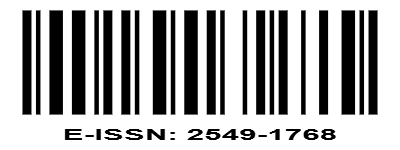THE VALIDITY OF HOTS ASSESSMENT INSTRUMENT ON CELL SUBJECT FOR STUDENT IN GRADE XI
DOI:
https://doi.org/10.22373/biotik.v9i1.6864Keywords:
Logical validity, Assessment Instruments, HOTS, Cell MaterialAbstract
Learning success is known through assessment. The 2013 Curriculum Assessment emphasizes assessments that train students to be able to Higher Order Thinking Skills (HOTS). HOTS capabilities according to Bloom's taxonomy include the ability to analyze, evaluate, and create. The results of observations note that students' HOTS ability is still lacking and the availability of HOTS assessment instruments for cell material used as guidelines is not yet available. One way to train students' HOTS is to develop an instrument of higher order thinking skills on cell material. This research is a 4D model development research, which is define, design, development, and dissemination. The research subjects consisted of 2 lecturers majoring in Biology FMIPA UNP. The object is assessment instrument HOTS on cell material. The results showed that the assessment instrument had an average value of 89.23% validity with valid criteria. The assessment instruments were developed based on aspects of material, construction, language, and higher order thinking skills. To be conclude, assessment instrument has valid and can be used to measure and train HOTS students, especially cell material.Downloads
References
Cahyono, A. E. 2017. Evaluasi Pelaksanaan Authentic Assessment Berdasarkan Kurikulum 2013 dalam Pembelajaran Ekonomi di SMA Islam Al-Hidayah Jember. Jurnal Equilibrium, 5 (1), 1-13.
Larkin, T. L. 2014. The Student Conference: A Model of Authentic Assessment. International Journal of Engineering Pedagogy, 4 (2), 36-46.
Sunarti dan Selly, R. 2014. Penilaian dalam Kurikulum 2013 (Menbantu Guru dan Calon Guru Mengetahui Langkah-langkah Pe-nilaian Pembelajaran.Yogyakarta: Andi.
Basuki. I., dan Hariyanto. 2015. Asesmen Pembelajaran. Bandung: Remaja Rosdakarya.
Riswanda, J. 2018. Pengembangan Soal Berbasis Higher Order Thinking Skill (HOTS) serta Implementasinya di SMA Negeri 8 Palembang. Jurnal Penelitian Pendidikan Biologi, 2 (1), 49-58.
Fanani, M. Z. 2018. Strategi Pe-ngembangan Soal Higher Order Thinking Skill (HOTS) dalam Kurikulum 2013. Jurnal, 2 (1), 57-76.
Ariyana, Y., Ari, P., Reisky, B., dan Zamroni. 2018. Buku Pegangan Pembelajaran Berorientasi pada Keterampilan Berpikir Tingkat Tinggi. Direktorat Jenderal Gru dan Tenaga Kependidikan Kemen-terian Pendidikan dan Kebudayaan.
Arifin. Z., dan Heri. R. 2017. Pengembangan Instrumen Pe-ngukur Higher Order Thinking Skill Matematika Siswa SMA Kelas X. Jurnal Pythagoras, 12 (1), 98-108.
Kementerian Pendidikan dan Ke-budayaan. 2013. Peraturan Mente-ri Pendidikan dan Kebudayaan Nomor 69 Tahun 2013, tentang Kerangka Dasar dan Struktur Kurikulum Sekolah Menengah Atas/Madrasah Aliyah.
Martin, M. O., Ina V.S., Mullis, Pierre, F., dan Martin, H. 2015. TIMSS 2015 International Results in Science. IEA.
OECD. 2019. PISA 2018 Results Combined Executive Summaries. Volume I, II, III. OECD Publising.
Haryanto. 2018. Pengembangan Instrumen Penilaian Kemampuan Berpikir Tingkat Tinggi pada Materi Fungi untuk Peserta Didik SMA/MA Kelas X. Skripsi. Universitas Negeri Padang. Padang. Indonesia. Maret 2018.
Purbaningrum, K. A. 2017. Kemampuan Berpikir Tingkat Tinggi Siswa SMP dalam Pemecahan Masalah Matematika Ditinjau dari Gaya Belajar. JPPM, 10 (2), 40-49.
Miarsyah, M., dan Rizhal H. R. 2019. Memberdayakan Keteram-pilan Mengembangkan Soal HOTS pada Guru Biologi di Kabupaten Bekasi. Jurnal Pengabdian pada Masyarakat, 1 (4), 151-159.
Sugiyono. 2017. Metode Peneliti-an & Pengembangan. Bandung: Alfabeta.
Departemen Pendidikan Nasional. 2017. Panduan Penilaian oleh Pendidik dan Satuan Pendidikan untuk Sekolah Menengah Atas. Jakarta: Direktorat Pembinaan SMA Ditjen Pendidikan Dasar dan Menengah.
Purwanto, N. 2009. Prinsip-prinsip dan Teknik Evaluasi Pembelajaran. Bandung: Remaja Rosdakarya.
Selaras, G. H., Yuni, A., Heffi, A., Des, M., dan Tri, P. W. 2019. Validitas dan Reliabilitas Intsru-men Penilaian Kemampuan Berpikir Tingkat Tinggi pada Materi Ruang Lingkup Biologi SMA. Bioeducation Journal, 3 (2), 151-158.
Downloads
Published
Issue
Section
License
Authors who publish with BIOTIK: Jurnal Ilmiah Biologi Teknologi dan Kependidikan agree to the following terms:
- Authors retain copyright and grant the journal right of first publication with the work simultaneously licensed under a Creative Commons Attribution License that allows others to share the work with an acknowledgement of the work's authorship and initial publication in this journal.
- Authors are able to enter into separate, additional contractual arrangements for the non-exclusive distribution of the journal's published version of the work (e.g., post it to an institutional repository or publish it in a book), with an acknowledgement of its initial publication in this journal.
- Authors are permitted and encouraged to post their work online (e.g., in institutional repositories or on their website) prior to and during the submission process, as it can lead to productive exchanges, as well as earlier and greater citation of published work.











